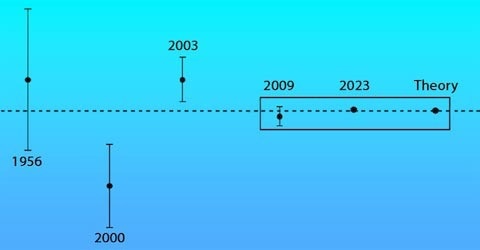To gain better insight into how light and matter interact at atomic and subatomic scales, researchers should strip their measurements of such interactions down to the bare essentials.

An illustration of different experimental results that have tested the theory of quantum electrodynamics; the 2023 results from CSU are the most precise (closest to the dotted line) to date. Image Credit: Colorado State University
In the lab of Dylan Yost, Associate Professor in Colorado State University’s Department of Physics, the study palette of choice is hydrogen, which is made up of just one proton and one electron.
Due to this element’s highly simple structure, Yost and his team could take measurements of forces within such individual atoms as they tried to combine those measurements with enduring theories regarding how the universe works.
In recent times, the lab achieved one such extremely accurate measurement—with the help of lasers, supercooled hydrogen, and radio frequency electromagnetic waves—that defines the magnetic interaction between the electron and proton in a hydrogen atom.
This quantum interaction manifests in the splitting of electron energy levels of the atom, which physicists pertain to as the “2S1/2 hyperfine interval.” Quantifying this interval is a coveted achievement for physics since it enables the testing of quantum theories with the help of real numbers.
The CSU physicists point out their achievement in the journal Physical Review Letters. By making use of a custom-built spectroscopy tool that includes cooling hydrogen atoms down to a few degrees Kelvin, the researchers were capable of capturing the magnetic interaction inside a single hydrogen atom within 1 part in 100 million.
This is the same precision you would have if you measured the distance from California to New York to an accuracy of about 1 centimeter.
Dylan Yost, Associate Professor, Department of Physics, Colorado State University
Their measurement assists the theory of quantum electrodynamics, which is a 100-year-old set of predictions inside the Standard Model of Physics. Quantum electrodynamics is known as the mathematical description of all feasible interactions between electrically charged particles through the movement and exchange of photons, which are considered to be elementary particles of light.
The measurement of the CSU group was in accordance with what the theory anticipated, which implied “the theorists working in quantum electrodynamics did a very good job,” stated Yost.
The group that was part of the project and authored the paper included CSU undergraduate students Michael Weiss and Scott Johnson, both of whom are excited by the outlook of assisting constrain confidence intervals around basic forces.
Eliminating possible precision errors in every step of our measurement was really cool to be a part of, and to see how it was all done.
Michael Weiss, Undergraduate Student, Colorado State University
Johnson was especially awed by the ability to work closely not only with the lab’s advanced instrumentation but also to pick up where others in the lab had left off to achieve their results.
What we’re doing is continuing to build that knowledge higher and higher.
Scott Johnson, Undergraduate Student, Colorado State University
Journal Reference
Bullis, R. G., et al. (2023) Ramsey Spectroscopy of the 2S1/2 Hyperfine Interval in Atomic Hydrogen. Physical reviews Letters. doi.org/10.1103/PhysRevLett.130.203001.